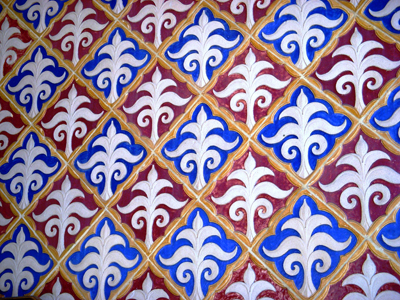
If you’re shopping for ceramic tiles, it’s likely you’ll run across the Italian terms ‘monocottura’ and ‘bicottura’. These refer to the firing process for the tiles, which can make a significant difference to the tile’s properties.

Bicottura tiles are often more decorative, but they’re generally not as strong as single fired tiles.
If you’re shopping for ceramic tiles there’s a good chance that sooner or later, you’ll run across these two Italian terms. Knowing what they mean is as much about understanding how tiles are made as it is about being down with the lingo.
To put it simply, monocottura means ‘single fired’ and bicottura means ‘double fired’ – but there are significant differences in terms of how strong these tiles are and how they perform – and therefore, the purposes for which you should use them.
What are monocottura tiles?
As we’ve already mentioned, Monocottura literally means ‘single-fired’ in Italian. Single-firing is a relatively new way to make tiles – the greenware (i.e. the clay before it’s fired) is shaped, glazed and fired in a roller kiln. This process all happens together and can take as little as an hour.
The monocottura process creates strong, durable ceramic tiles with a hard glaze. Because they’re generally tougher and harder wearing than double-fired tiles, monocottura tiles are favoured as floor tiles, and for use in outdoor applications.
The bond between the glaze and the ‘biscuit’ is also more resilient in monocottura tiles, and they’re less prone to peeling and ‘crazing’ (i.e. the appearance of tiny spiderweb-like cracks due to movement or slight changes in the ‘biscuit’ over time).
Monocottura tiles also have a nice flat back surface, which makes them easier to install than the older style bicotturas.
What are bicottura tiles?
If you’re a shrewd kind of person, you’ve probably already guessed that bicottura means ‘double fired’. For these tiles, a simple ‘biscuit’ is first made with a single firing of an unglazed tile. This is then coated with a glaze, and fired a second time to complete the tile.
This process can take several days, and produces ceramic tiles that are less durable than monocottura tiles, because the glaze doesn’t set and strengthen as well as it does with single-fired ceramic tiles. The bicottura process is much older, and still thought to produce better decorative tiles.
Because bicottura tiles are usually softer, they’re better suited for walls and splashbacks where they’re not likely to be knocked around too much.
Bicottura ceramic tiles are also produced with lugs on the back of them as a by-product of the manufacturing process – which makes them a complicated option for floor tiles.





